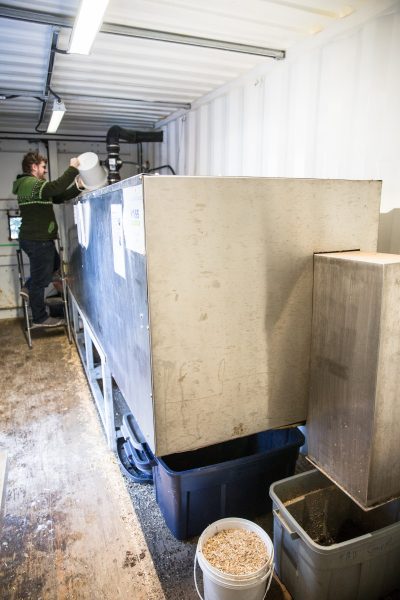What do dried leaves, a banana peel, coffee grounds and James Gordon’s old T-shirts have in common? Every one of those items can be diverted from the garbage bin, saved from the landfill and turned into compost!
The days are longer, winter coats have been cast to the back of the closet and avid gardeners have already started planning for planting season: it’s the perfect time to talk compost.
Gordon joined the sustainability ranks at TRU more than five years ago as environmental programs and research co-ordinator, and knows the ins and outs and the importance of our vast campus compost system.
“There are two very positive outcomes of composting. One, you get a valuable soil additive at the end of it. But most importantly, in this era of climate change, you keep material out of the landfill. Which means that material doesn’t produce the potent greenhouse gas methane,” he said.
The path from orange peel to compost, or “black gold,” all starts at one of more than 70 Zero Waste Stations on campus. A janitorial staff member collects the food waste items from the Zero Waste Stations, the smaller countertop bins placed in staff and faculty kitchens and the Campus Activity Centre kitchen. Food waste from the Culinary Arts Training Centre is collected and used by a local farmer.
The composting machine resembles a giant, stainless steel deep freezer with a spout on top to add items and a spout at the other end that churns out material. Nearby are bins upon bins of freshly composted material ready to be transported to a curing pile. Compost that is too ripe can damage plant root systems because the nutrients aren’t balanced yet. For this reason, compost from TRU needs to cure for about one year. After the curing period, our grounds crew uses it across campus.

Food waste goes in, and compost comes out of TRU’s campus compost machine.
Home composting can take slightly more planning and time, but thanks to TRU’s streamlined system, it’s incredibly easy to compost on campus. Gordon stressed that students living in residences on campus should feel welcome to collect their own food waste and utilize the Zero Waste Stations.
Gordon has plenty of advice and helpful tips for anyone interested in starting up a home composting system. There are a few perceived drawbacks about compositing, including potential unpleasant smells.
“There are ways to make it easy on yourself. Compost is really just like baking. It’s all chemistry as far as reducing the smell, increasing the speed and ending up with a good product.”
Tips like making sure to add equal parts dry organic material (leaves, grass clippings, or wood shavings) to the food waste is key in keeping smells down and speeding up the process.
Using four compost systems at his own house, Gordon composts a range of organic materials, even the most unlikely items including his old cotton underwear and T-shirts (which are organic materials once any synthetic pieces are removed, like the rubber bands). Besides the food-waste composter, he has one for meat products, one for yard clippings and even one for dog waste (but this compost is never used on food-producing plants).
As we approach Earth Day on April 22, remember to always use the Zero Waste Stations on campus and think about adopting your very own home compost system.
“Some people think ‘Ugh, I’m not doing compost, that’s gross!’ But I always try to encourage them that it’s the right thing to do for the planet, and it’s not that tough once you have the basics figured out,” he said.
Home composting 101
- Pick a sunny location to place the compost. It can be in a special compost bin, chicken wire in the shape of a cylinder, a tumbler or simply a pile right on the ground (although this last option can attract birds and/or rodents).
- Collect food scraps. The most common items are fruits and veggies, bread products, grains, meat and fish, chicken and fish bones, eggs and egg shells, tea bags and coffee grounds and filters.
- Don’t forget to collect organic material like 100 percent cotton and paper. This includes compostable cutlery, paper towels, cardboard pizza plates and paper clamshells with or without food in it. Like composting anything, breaking this down into smaller pieces help speeds up the process.
- Collect totally dry organic material like leaves, grass clippings, hay or wood shavings.
- Layer equal amounts of food scraps with dry organic material. An easy way to do this is to add the same amount of leaves/grass/wood shavings each time you add food scraps.
- Turn the pile every few weeks. It’s recommended to use a pitchfork or a compost mixing tool.
- Your black gold is ready for use once it’s dark and crumbly!
Do not add:
- Dairy products
- Fatty food waste
- Large bones like beef or lamb
- Liquids
- Any human biological waste
- Pet waste*
*While it is possible to compost dog waste, it’s a much more advanced practice. It must take place separately from other compost and must only be used to grow non-consumables.
For more information on all things sustainable at TRU, visit the Sustainability website.

